In 2017, Coffee Review began exploring the vibrant roasting scenes in various regions of the U.S., beginning with last year’s popular tasting report on coffees of the American Southwest. This year we take a look at roasters in the U.S. mountain states: Colorado, Idaho, Montana, Utah, and Wyoming.
We received samples from all five states. Of the many lovely and interesting coffees among them, the 11 highest-rated are reviewed here, with impressive scores ranging from 92 to 96. They include seven Kenyas, two Ethiopias, one Colombia, and a Panama produced from the celebrated Geisha variety of Arabica. Generally, these coffees tended toward the familiar or “classic” in regard to both origin and style. Each of the seven Kenyas, for example, was exhilaratingly different in profile, yet all were superb and intriguing variations on the great wet-processed Kenya cup. The 92-rated Colombia from Jackrabbit Java in Thermopolis, Wyoming is also a quintessentially classic type, a fine wet-processed Colombia from the Nariño growing region.
The three outliers among the 11 coffees we review here may also be types familiar to lovers of specialty coffee, but are seen much less often on the average café menu across the country. Two are natural-processed (dried-in-the-fruit) Ethiopias, a fruit-forward style that has become increasingly popular over the last 10 years: the Caffeic Ethiopia (93) and the Desert Sun Organic Ethiopia Sidama Natural (92). The highest-rated sample, Dragonfly Coffee’s Esmeralda Estate Porton Geisha Natural (96), was produced on the Panama farm that first rediscovered the Geisha variety, and processed by the natural method.
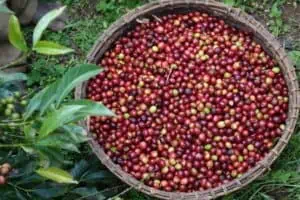
Just-picked coffee cherries in the Sidamo growing region of Ethiopia. Courtesy of Desert Sun Coffee Roasters.
The relative success of classic wet-processed coffees in this cupping might be mostly a coincidence, though it could also be attributed to regional consumer preferences, a hypothesis suggested by some of the interviews with roasters featured here.
While we received submissions from all five states, the coffees that met our score cutoff were from Colorado, Idaho, Montana and Wyoming. We had several worthy samples from Utah, but none that cracked 92, this month’s cutoff score for review. (We set a minimum score for reviews appearing with each report based on the range for the top-scoring 10 samples for that report, although we often review more than 10 if there are ties.)
High-Elevation Roasting Challenges
Roasting coffee is both an art and a science. Roasters use both their senses and instruments to carefully monitor the progress of the roast. They strategically adjust complex variables that impact the intensity and timing of transfer of heat to the beans over the course of roasting a specific green coffee, all aimed at achieving what is, for them, the optimum sensory profile for that coffee.
But beans respond differently at higher elevations than they do at moderate elevations. Cooks, for example, know that cooking processes and reactions are altered, often radically, as one moves to higher elevations. Water boils at 212 Fº degrees Fahrenheit at sea level, while in Denver, at 5,280 feet, it boils at 202Fº degrees. Like experienced cooks, coffee roasters know that formulas and numbers based on roasting at lower elevations will be different at higher elevations, arguably encouraging independent observation and self-reliance.
Brother Paul-Marie, of Mystic Monk in Clark, Wyoming (4,500 feet), whose Kenya we review here at 93, says, “The dry [mountain] air makes storing green beans a challenge, and gale-force winds can make airflow more difficult to control.” Tamas Christman, of Dragonfly Coffee in Boulder, Colorado (5,328 feet) reports that roasting coffee at altitude is definitely a challenge: “Profiling can be [particularly] time-consuming, but it’s of utmost importance in ensuring the achievement of optimal roast.”
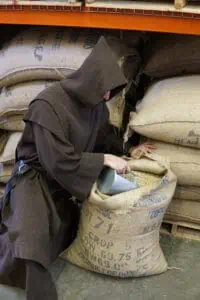
Roasting at Mystic Monk in Clark, Wyoming. Courtesy of Mystic Monk.
Andy Sprenger, of Sweet Bloom Coffee Roasters in Denver, Colorado (Kenya Kainamui, 93), says that he and his head roaster Jin Chiew used to roast at sea level, but now work at 5,518 feet. “Although we continue to make small adjustments to how we roast in Denver,” Sprenger acknowledges, “I can’t say that any are directly related to altitude. But water boils here at 200 degrees Fahrenheit, and although our roasts are on the lighter end of the spectrum, I do wonder if we develop them ever so slightly more to compensate for the lower brew temperatures available.”

Green coffee on offer at the Kariru factory in Kenya. Courtesy of Corvus Coffee Roasters.
Phil Goodlaxson of Corvus Coffee Roasters (Kenya Kariru, 92), also in Denver, adds, “Everything happens a bit quicker at altitude; chemical reactions in the beans get jump-started slightly earlier.”
Weather and Logistics in Mountain States
Seasonal variations in temperature at higher elevations result in more extreme weather across the board, and winter is a major factor for many mountain-states roasters. Gary Thiesen of Revel Coffee in Billings, Montana, whose Kenya Kiambu we review here at 94, says one of his biggest challenges is keeping the roasting warehouse as climate-stable as possible — and not getting the forklift stuck in the snow when receiving pallets.
Josh Thomas, of Jackrabbit Java in Thermopolis, Wyoming, adds, “Our main truck shipping route runs through a large canyon to the south of town, and it is often closed due to snow or rock slides, which essentially closes our supply channels. Because of this, we probably stock twice as much green coffee as a roaster our size would need to in other locales.”
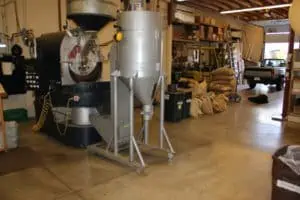
The roastery at Durango Coffee in Durango, Coloradao. Courtesy of Durango Coffee Roasters.
Carl Rand, of Durango Coffee Company in Durango Colorado (Kenya, 92), had his Probat roaster specially engineered to head off some of the known challenges of roasting at 6,500 feet (the highest altitude among the roasters included in this report, a distinction shared with Desert Sun, also in Durango). Rand says, “The burners were calibrated for the altitude and the fans oversized to accommodate the thinner air, as less dense air results in slower cooling time.” Lack of humidity is also potentially problematic at altitude. Rand says his roastery stores all of its coffee in GrainPro hermetic, gas-tight storage bags to extend the shelf life of the green coffee by preventing aggressive drying.
And winter isn’t the only season that presents issues. Scott Bouma, of Caffeic in Helena, Montana, says, “One challenge with roasting in Montana is the weather, which varies from over 100 degrees in the summer to -40 degrees in the winter. We definitely make fine adjustments to our roasting style as the seasons change to compensate for the fluctuating outdoor air temperatures.”
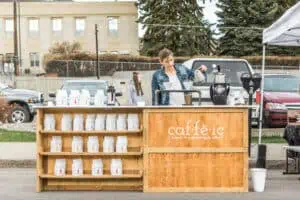
Caffeic’s farmers’ market stand in Helena, Montana. Courtesy of Caffeic.
Desert Sun’s Liz Nelson grew up in Colorado, so she doesn’t have a point of reference for roasting at lower altitudes. What she does note is that being in a remote area of Colorado poses logistical issues, not only for receiving green coffee, but also for shipping out roasted coffee, which in turn impacts access to broader markets. Brother Paul-Marie, of Mystic Monk, concurs: “Interestingly enough, we find the biggest challenge to be logistics. Shipping coffee from either coast to Wyoming is very expensive, and truck capacity can be hard to come by during the holiday season.“
Third Wave Coffees Don’t Always Rule
One common way of understanding the recent history of coffee is to think of it in terms of three stages, or “waves.”
The first wave crested in the 1950s to the 1970s, with the complete domination in stores of nationally branded pre-ground blends and instant coffees, and, in restaurants and diners, medium-roasted, drip coffee in urns or bubble pots. The second wave, roughly from the 1970s to the present, marks the revival of coffee as an artisanal beverage, although usually dark-roasted to help distinguish it from the medium roasts of the first wave. Outside home and office, Americanized versions of the European café serving milk-heavy espresso drinks expanded from urban enclaves to strip malls. The third wave began in the early 2000s and is still going strong today, often taking the notion of artisanal to the level of bespoke. Specifically identified single-origin coffees are brought to a light roast to highlight the taste of the bean, rather than the taste of the roast. Cafés routinely offer multiple brewing methods with a focus on the coffee itself, rather than big, milky espresso drinks.
This is an over-generalized historical picture, but a useful one, as long as one understands that versions of all three of these waves are still with us, competing, morphing, overlapping — all trying to tell us how to understand and buy coffee. In many metropolitan neighborhoods of the U.S. third-wave coffee is ubiquitous, though certainly not universal, while smaller cities and more rural areas still lean toward second-wave styles.
Randy Lint, of Big Creek Coffee Roasters in Hamilton, Montana (Kenya Gatuya, 93) says, “The more rural culture has people spread out, and sometimes innovation can be met with skepticism. But more traditional coffee-drinkers are also interested and profoundly loyal. They love new experiences, and they love a good story. They’re not all going to love a fruit-bomb natural Ethiopia, but they will appreciate the experience of trying it.”
At least three of the top-rated coffees reviewed this month are definitely medium-roasted rather than light-roasted, and one — the Mystic Monk Kenya — is clearly darker-roasted, all ample evidence that quality doesn’t only come in the form of the lighter-roasted coffees that are the darlings of the third-wave movement.
According to Christman, coffee culture in the mountain states is “progressive and still developing.” His philosophy is to “make the world’s finest coffees approachable for all consumers through education, empowerment, sustainability and unique sensory experiences.”
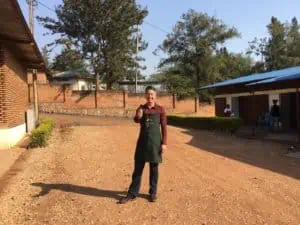
Tamas Christman of Dragonfly Coffee on a souring trip to Rwanda. Courtesy of Darrin Daniel.
Goodlaxson, also based in relatively urban Denver, adds, “Roasters here feel like we have something to prove because we are later in developing a specialty culture. At the same time, we have wide acceptance because people are already drinking craft beer. And because we’re not like Seattle and Portland in terms of coffee innovation, we have a high bar to reach. We can stand on the shoulders of giants without any of their baggage.”
Durango is a much smaller town than Denver, and Nelson observes that, “Durango, as a whole, is still very much into darker roasts and blends, whereas my passion is lighter-roasted single origin coffees. Here at Desert Sun Coffee, we work very hard to educate and inspire our customers, being transparent about where and how we source our coffees, the nuances of different regions, proper extraction practices, and the importance of organic. I’d like to think we play a role in bringing our little second-wave coffee town into the third wave.”
Reckoning with Remoteness
Many roasters in U.S. mountain states are in small towns, remote from urban commerce and established coffee sub-cultures. Jackrabbit Java’s Thomas muses about the pros of cons of being coffee-obsessed in tiny Thermopolis, which is home to just over 3,000 people: “Wyoming is the least densely populated state in the nation, which means we count on repeat local customers to survive. We try to offset the low customer base by offering online sales and providing high-quality value coffees to our customers — we sell 90+ -rated coffees for $12 a bag.” He says that coffee culture in Wyoming is in its infancy, having just held its first-ever coffee festival, Roasters Rendezvous, this past September, in which roasters from the state all came together to offer coffee samples to the attendees. (Jackrabbit Java won the people’s choice award at the event.)
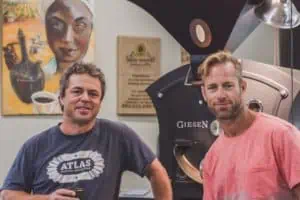
Randy and Rick Evans, of Evans Brothers Coffee in Sandpoint, Idaho. Courtesy of Evans Brothers Coffee.
And Randy Evans, of Evans Brothers Coffee in Sandpoint, Idaho, says, “Sandpoint is pretty far north — less than 60 miles from Canada — and relatively isolated. It’s been gratifying to see the culture of craft coffee take hold in the Inland Northwest. We wanted to meet people where they were, to be approachable, but also to introduce them to how special a cup of coffee can be.”










